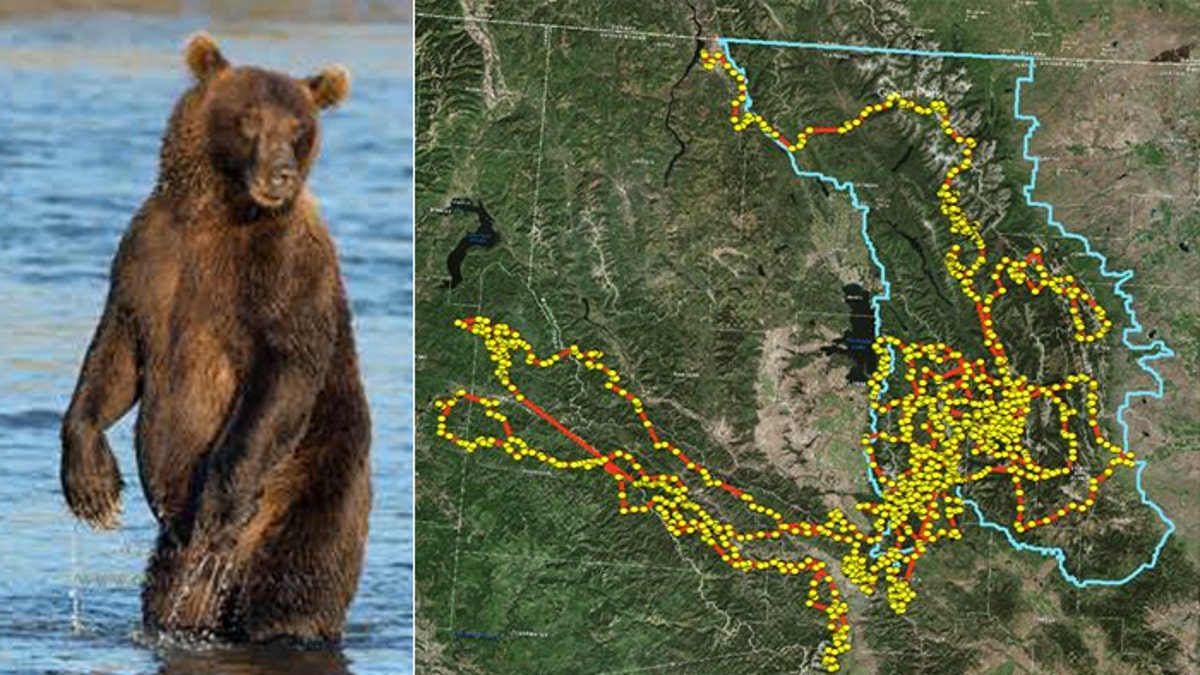
Busy bear: A grizzly like the one pictured rambled 2,800 miles throughout Montana and Idaho, according to conservationists who tracked her.
Backyard romps, strolls down main street and across a highway and rugged mountain hikes were all part of a grizzly bear named Ethyl's "bizarre" 2,800-mile itinerary over the last three years, according to wildlife researchers, who say the bruin's rambles offer a glimpse into how the fearsome beasts co-exist with man.
The 20-year-old grizzly sow, who was first tagged with a tracking device in 2006, traveled throughout Montana and Idaho, in an amazing walkabout that has a group of state and federal conservationists amazed as they comb through the data. While grizzlies have been known to range long distances, Ethyl's wanderings were dubbed "bizarre" by one scientist, and believed to have been prompted by her relocation from an unsafe area and long, unsuccessful search for familiar territory.
“The area and terrain she covered was pretty significant,” Lori Roberts, a researcher with the Interagency Grizzly Bear Committee, told FoxNews.com. “She just wasn’t travelling on flat ground. She made huge crossings across mountains, rivers, and even towns.”
[pullquote]
Ethyl had spent most of her two decades of life around the Lake Blaine area near the Swan Mountains of Montana until she was first captured while raiding an apple orchard in 2006 and released back into the wild with a radio collar.
“The data showed that she stayed in her home range the first time,” Roberts said.
But when Ethyl was captured at the same orchard in 2012 with her 2-year-old cub in tow, she was moved for safety reasons and outfitted with a new radio collar which sent GPS data to a satellite once a week. The information that was collected over the next three years proved astonishing as Ethyl searched in vain to find a way back to her home range near Lake Blaine.
The tracker enabled biologists from the committee, which includes Montana and Idaho conservation officials as well as U.S. Fish and Wildlife Service agents, to trace Ethyl’s hike across the landscape. They discovered that the grizzly had traveled through the Bob Marshall Wilderness, hitting a few peaks of the Rockies, heading down to the Mission Mountains and the area near Jocko Lakes before making her way to the northern fringe of the Bitterroot Mountains and into Idaho.
[image]
Ethyl then traveled north along the Interstate 90 corridor, passing the towns of Wallace and Kellogg before denning in the panhandle before her collar was shut off a year ago to conserve battery power while she hibernated. The GPS was reactivate last spring, and showed Ethyl was already on the move again. By May, she had reached the southern outskirts of Missoula, Mont., on her way toward the town of Lolo. On May 20, while most of the town of a little less than 4,000 slept, Ethyl took a tour of downtown.
“She goes basically right through downtown Lolo and we didn't have any sightings,” Chris Servheen, grizzly bear recovery program coordinator for the U.S. Fish and Wildlife Service, told The Missoulian. “She was minding her own business, walking around trying to figure out where she is.”
Along the way, Ethyl rooted through municipal landfills, wandered in backyards and even crossed I-90.
“The one thing we can say is this was not representative of normal bear movement, and certainly not female grizzly bear movement,” said Servheen. “She had some really bizarre travels.”
[image]
Ethyl almost made it back to her home range but bypassed it as she headed to Glacier National Park earlier this year. She spent some time there before heading west towards Eureka and eventually shedding her collar on Oct. 17.
Roberts said that Ethyl’s journey is a significant finding in how grizzly bears migrate.
“Her movements are very uncommon,” she told FoxNews.com. “We see males make these movements often to procreate we never have seen a female do this.”
When all is said and done, Ethyl had covered nearly 3,000 miles and has likely has many more before she next sleeps for winter.
“We know she was healthy,” Roberts said adding that they hope to be able to track her down again. “We will just have to wait and see.”
Ethyl was named for the owner of the apple orchard where she first was caught by Montana wildlife officers in September 2006. Officials believe she could have cubs again, possibly up to age 28 or 30, which would be near the end of her life span.

